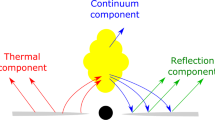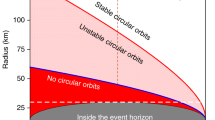Abstract
I review the current status of X-ray reflection (a.k.a. broad iron line) based black hole spin measurements. This is a powerful technique that allows us to measure robust black hole spins across the mass range, from the stellar-mass black holes in X-ray binaries to the supermassive black holes in active galactic nuclei. After describing the basic assumptions of this approach, I lay out the detailed methodology focusing on “best practices” that have been found necessary to obtain robust results. Reflecting my own biases, this review is slanted towards a discussion of supermassive black hole (SMBH) spin in active galactic nuclei (AGN). Pulling together all of the available XMM-Newton and Suzaku results from the literature that satisfy objective quality control criteria, it is clear that a large fraction of SMBHs are rapidly-spinning, although there are tentative hints of a more slowly spinning population at high (M>5×107 M ⊙) and low (M<2×106 M ⊙) mass. I also engage in a brief review of the spins of stellar-mass black holes in X-ray binaries. In general, reflection-based and continuum-fitting based spin measures are in agreement, although there remain two objects (GRO J1655–40 and 4U 1543–475) for which that is not true. I end this review by discussing the exciting frontier of relativistic reverberation, particularly the discovery of broad iron line reverberation in XMM-Newton data for the Seyfert galaxies NGC 4151, NGC 7314 and MCG–5-23-16. As well as confirming the basic paradigm of relativistic disk reflection, this detection of reverberation demonstrates that future large-area X-ray observatories such as LOFT will make tremendous progress in studies of strong gravity using relativistic reverberation in AGN.







Similar content being viewed by others
Notes
In the lamp-post geometry, the X-ray source is situated at some height above the disk plane on the spin-axis of the black hole.
References
E. Agol, J.H. Krolik, Astrophys. J. 528, 161 (2000)
N. Andersson, K.D. Kokkotas, N. Stergioulas, Astrophys. J. 516, 307 (1999)
J. Bardeen, W.H. Press, S.A. Teukolsky, Astrophys. J. 178, 347 (1972)
P. Barr, N.E. White, C.G. Page, Mon. Not. R. Astron. Soc. 216, 65 (1985)
V. Bennert, M.W. Auger, T. Treu, J.H. Woo, M.A. Malkan, Astrophys. J. 726, 59 (2011)
R.D. Blandford, R.L. Znajek, Mon. Not. R. Astron. Soc. 179, 433 (1977)
J.L. Blum et al., Astrophys. J. 706, 60 (2009)
L.W. Brenneman, C.S. Reynolds, Astrophys. J. 652, 1028 (2006)
L.W. Brenneman et al., Astrophys. J. 736, 103 (2011)
Y. Dabrowski, A.C. Fabian, K. Iwasawa, A.N. Lasenby, C.S. Reynolds, Mon. Not. R. Astron. Soc. 288, L11 (1997)
T. Dauser, J. Wilms, C.S. Reynolds, L.W. Brenneman, Mon. Not. R. Astron. Soc. 409, 1534 (2010)
B. de Marco, G. Ponti, P. Uttley, M. Cappi, M. Dadina, A.C. Fabian, G. Miniutti, Mon. Not. R. Astron. Soc. 417, L98 (2011)
R. Duro et al., Astron. Astrophys. 533, L3 (2011)
A.C. Fabian, M.J. Rees, L. Stella, N.E. White, Mon. Not. R. Astron. Soc. 238, 729 (1989)
A.C. Fabian et al., Nature 459, 540 (2009)
A.C. Fabian et al., Mon. Not. R. Astron. Soc. 424, 217 (2012a)
A.C. Fabian et al., Mon. Not. R. Astron. Soc. 419, 116 (2012b)
A.C. Fabian et al., Mon. Not. R. Astron. Soc. 429, 2917 (2013)
M. Feroci et al., Exp. Astron. 34, 415 (2012)
L.C. Gallo, G. Miniutti, J.M. Miller, L.W. Brenneman, A.C. Fabian, M. Guainazzi, C.S. Reynolds, Mon. Not. R. Astron. Soc. 411, 607 (2011)
O. Gonzáles-Martin, S. Vaughan, Astron. Astrophys. 544, 80 (2012)
L. Gou et al., Astrophys. J. 742, 85 (2011)
B. Hiemstra, M. Mendez, C. Done, M. Diaz Trigo, D. Altamirano, P. Casella, Mon. Not. R. Astron. Soc. 411, 137 (2011)
K. Iwasawa et al., Mon. Not. R. Astron. Soc. 282, 1038 (1996)
T. Kallman, M. Bautista, Astrophys. J. Suppl. Ser. 133, 221 (2001)
E. Kara, A.C. Fabian, E.M. Cackett, G. Miniutti, P. Uttley, Mon. Not. R. Astron. Soc. 430, 1408 (2013a)
E. Kara, A.C. Fabian, E.M. Cackett, J.F. Steiner, P. Uttley, D.R. Wilkins, A. Zoghbi, Mon. Not. R. Astron. Soc. (2013b, in press). arXiv:1306.2551
R.P. Kerr, Phys. Rev. Lett. 11, 237 (1963)
A.R. King, J.E. Pringle, Mon. Not. R. Astron. Soc. 373, L90 (2006)
A.L. King et al., Astrophys. J. 729, 19 (2011)
A.L. King et al., Astrophys. J. 762, 103 (2013)
A.M. Lohfink, C.S. Reynolds, J.M. Miller, L.W. Brenneman, R.F. Mushotzky, M.A. Nowak, A.C. Fabian, Astrophys. J. 758, 67 (2012b)
A.M. Lohfink, C.S. Reynolds, R.F. Mushotzky, J. Wilms, Astrophys. J. 749, L31 (2012a)
P. Magdziarz, A. Zdziarski, Mon. Not. R. Astron. Soc. 273, 837 (1995)
A. Malizia et al., Mon. Not. R. Astron. Soc. 389, 1360 (2008)
J.E. McClintock et al., Astrophys. J. 652, 518 (2006)
I.M. McHardy, K.F. Gunn, P. Uttley, M.R. Goard, Mon. Not. R. Astron. Soc. 359, 1469 (2005)
J.M. Miller et al., Astrophys. J. 570, L69 (2002)
J.M. Miller et al., Astrophys. J. 606, L131 (2004)
J.M. Miller et al., Nature 441, 953 (2006)
J.M. Miller et al., Astrophys. J. 680, 1359 (2008)
J.M. Miller, C.S. Reynolds, A.C. Fabian, G. Miniutti, L. Gallo, Astrophys. J. 697, 900 (2009)
J.M. Miller et al., Astrophys. J. 724, 1441 (2010)
L. Miller, T.J. Turner, J.N. Reeves, V. Braito, Mon. Not. R. Astron. Soc. 408, 1928 (2010)
J.M. Miller, M.C. Miller, C.S. Reynolds, Astrophys. J. 731, L5 (2011)
G. Miniutti et al., Mon. Not. R. Astron. Soc. 398, 255 (2009)
T. Nagao, R. Maiolino, A. Marconi, Astron. Astrophys. 459, 85 (2006)
K. Nandra, P.M. O’Neill, I.M. George, J.N. Reeves, Mon. Not. R. Astron. Soc. 382, 194 (2007)
I.D. Novikov, K.S. Thorne, in Black Holes, ed by. C. Dewitt, B.S. Dewitt (Gordon & Breach, New York, 1974), p. 343
A.R. Patrick, J.N. Reeves, D. Porquet, A.G. Markowitz, V. Braito, A.P. Lobban, Mon. Not. R. Astron. Soc. 426, 2522 (2012)
R.F. Penna, J.C. McKinney, R. Narayan, A. Tchekhovskoy, R. Shaffe, J.E. McClintock, Mon. Not. R. Astron. Soc. 408, 752 (2010)
B.M. Peterson et al., Astrophys. J. 613, 682 (2004)
R.C. Reis, A.C. Fabian, R.R. Ross, J.M. Miller, Mon. Not. R. Astron. Soc. 395, 1257 (2009)
R.C. Reis et al., Mon. Not. R. Astron. Soc. 410, 2497 (2011)
R.C. Reis et al., Astrophys. J. 745, 93 (2012a)
R.C. Reis, J.M. Miller, M.T. Reynolds, A.C. Fabian, D.J. Walton, Astrophys. J. 751, 34 (2012b)
C.S. Reynolds, M.C. Begelman, Astrophys. J. 488, 109 (1997)
C.S. Reynolds, A.C. Fabian, Astrophys. J. 675, 1048 (2008)
C.S. Reynolds, A.J. Young, M.C. Begelman, A.C. Fabian, Astrophys. J. 514, 164 (1999)
C.S. Reynolds, L.W. Brenneman, A.M. Lohfink, M.L. Trippe, J.M. Miller, A.C. Fabian, M.A. Nowak, Astrophys. J. 755, 88 (2012)
R.R. Ross, A.C. Fabian, Mon. Not. R. Astron. Soc. 358, 211 (2005)
R.R. Ross, A.C. Fabian, Mon. Not. R. Astron. Soc. 381, 1697 (2007)
S. Schmoll et al., Astrophys. J. 703, 2171 (2009)
R. Shafee et al., Astrophys. J. 687, L25 (2008)
N.I. Shakura, R.A. Sunyaev, Astron. Astrophys. 24, 337 (1973)
M. Sikora, L. Stawarz, J. Lasota, Astrophys. J. 658, 815 (2007)
J.F. Steiner et al., Mon. Not. R. Astron. Soc. 416, 941 (2011)
J.F. Steiner et al., Mon. Not. R. Astron. Soc. 427, 2552 (2012)
Y. Tan, J.X. Wang, W. Shu, Y. Zhou, Astrophys. J. 747, L11 (2012)
M. Volonteri, P. Madau, E. Quataert, M.J. Rees, Astrophys. J. 620, 69 (2005)
D.J. Walton, E. Nardini, A.C. Fabian, L.C. Gallo, R.C. Reis, Mon. Not. R. Astron. Soc. 428, 2901 (2013)
C. Warner, F. Hamann, M. Dietrich, Astrophys. J. 608, 136 (2004)
A.J. Young, R.R. Ross, A.C. Fabian, Mon. Not. R. Astron. Soc. 300, L11 (1998)
X.-L. Zhou, J.-M. Wang, Astrophys. J. 618, L83 (2005)
A. Zoghbi, A.C. Fabian, Mon. Not. R. Astron. Soc. 418, 2642 (2011)
A. Zoghbi, A.C. Fabian, P. Uttley, G. Miniutti, L.C. Gallo, C.S. Reynolds, J.M. Miller, G. Ponti, Mon. Not. R. Astron. Soc. 401, 2419 (2010)
A. Zoghbi, P. Uttley, A.C. Fabian, Mon. Not. R. Astron. Soc. 412, 59 (2011)
A. Zoghbi, A.C. Fabian, C.S. Reynolds, E.M. Cackett, Mon. Not. R. Astron. Soc. 422, 129 (2012)
A. Zoghbi, C.S. Reynolds, E.M. Cackett, G. Miniutti, E. Kara, A.C. Fabian, Astrophys. J. 767, 121 (2013)
Acknowledgements
I thank Andy Fabian, Anne Lohfink, Jon Miller and Abdu Zoghbi for invaluable discussion during the writing of this review. I gratefully acknowledge support from NASA under ADAP grant NNX12AE13G.
Author information
Authors and Affiliations
Corresponding author
Rights and permissions
About this article
Cite this article
Reynolds, C.S. Measuring Black Hole Spin Using X-Ray Reflection Spectroscopy. Space Sci Rev 183, 277–294 (2014). https://doi.org/10.1007/s11214-013-0006-6
Received:
Accepted:
Published:
Issue Date:
DOI: https://doi.org/10.1007/s11214-013-0006-6




